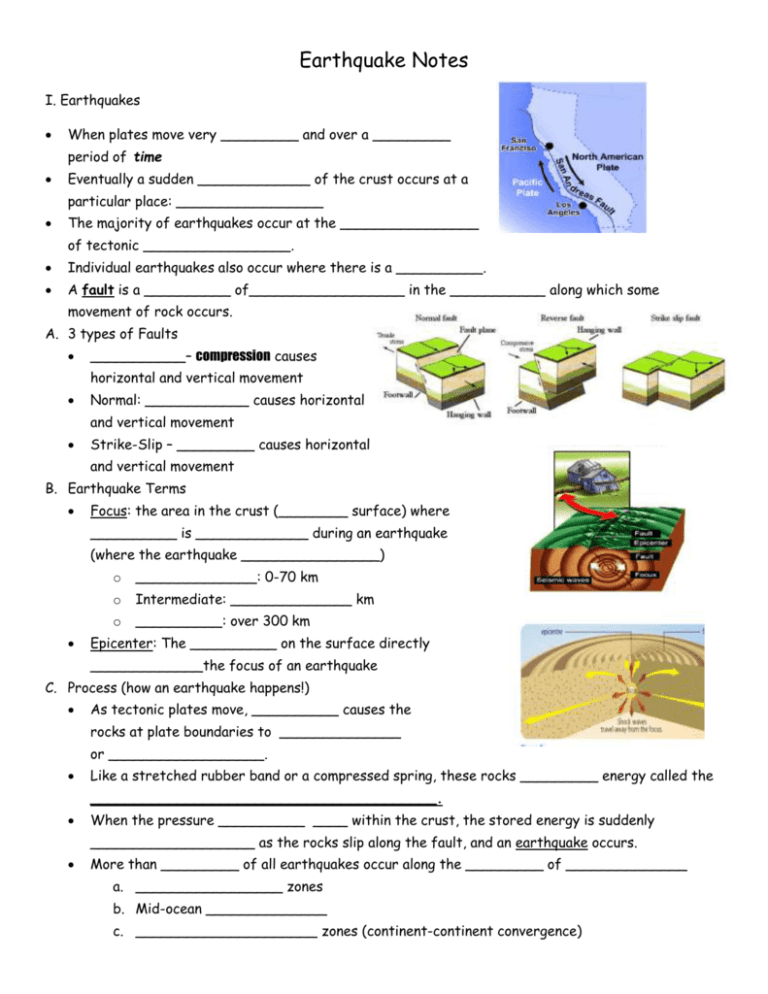Earthquake notes
advertisement

Earthquake Notes I. Earthquakes When plates move very _________ and over a _________ period of time Eventually a sudden _____________ of the crust occurs at a particular place: _________________ The majority of earthquakes occur at the ________________ of tectonic _________________. Individual earthquakes also occur where there is a __________. A fault is a __________ of__________________ in the ___________ along which some movement of rock occurs. A. 3 types of Faults ___________– compression causes horizontal and vertical movement Normal: ____________ causes horizontal and vertical movement Strike-Slip – _________ causes horizontal and vertical movement B. Earthquake Terms Focus: the area in the crust (________ surface) where __________ is _____________ during an earthquake (where the earthquake ________________) o ______________: 0-70 km o Intermediate: ______________ km o __________: over 300 km Epicenter: The __________ on the surface directly _____________the focus of an earthquake C. Process (how an earthquake happens!) As tectonic plates move, __________ causes the rocks at plate boundaries to ______________ or __________________. Like a stretched rubber band or a compressed spring, these rocks _________ energy called the ________________________________________. When the pressure __________ ____ within the crust, the stored energy is suddenly ___________________ as the rocks slip along the fault, and an earthquake occurs. More than _________ of all earthquakes occur along the _________ of ______________ a. _________________ zones b. Mid-ocean ______________ c. _____________________ zones (continent-continent convergence) D. Seismology The study of _____________________________ Scientists ____________ predict the ____________ date and time of an earthquake But… they can identify areas __________ to have an earthquake in the next ____ years. A _______________ measures earthquakes, and seismologists use seismic waves to study The __________ released by an earthquake _____________ away from the focus in__________________ _____________: relative size of an earthquake depends on _____________ energy released Seismographs show the kinds of ________, their ___________________, and the ___________ of the waves ______________ are small tremors that _________ an earthquake Aftershocks are small tremors that follow _______ an earthquake E. Scales • Magnitude is expressed on the __________________________ – Study the waves to determine the _______________ and location of the earthquake – Uses number ___ & ____ – Each # indicates_______ times stronger than the # ___________ • Ex: A rating of ___ has a magnitude ten times as great as an earthquake with a magnitude of ___ – 7 or __________ indicates a major earthquake ( 10-felt all over the ____________) • Modified Mercalli Scale: use to rate _____________ – Roman numerals __ to _____ describes ___________ done by the quake – XII : ___________ destruction – An earthquake with one magnitude, damage can __________ depending on the location F. Seismic Waves The ____________ of potential to kinetic energy results in seismic __________ Travel through the ground _____ times faster than the speed of sound Seismic waves reach the ____________ at the ___________________ Body waves – originate from the _______ of the earthquake P waves (____________ waves) are compression waves that _____ and ______ rock as they travel i. Cause particles to move ______ & ________ ii. Move through _______, liquids and __________ iii. 1st waves to ___________ at earthquake S waves – (shear/ ______________ waves) Body waves that have reached the surface i. Cause particles to move ______ to _______ ii. Do _________ travel through liquids Surface Waves: ________ & _________ waves Love waves & Rayleigh waves Travel along the _____________& more __________ Cause the _________ damage Love: ____ vertical movement of the surface Rayleigh: ______ horizontal and vertical movement G. How to determine the distance to the epicenter Need data from ____________ seismographic stations including the spread of S and P waves and the ___________ between the arrival of the s and p waves. Forecasting o Based on calculating the _______________ o 2 factors ______________ of area ______________ at which strain builds up H. Earthquake Hazards Factors that determine the severity of damage o ______________ of buildings ______________ structure = _________ damage 2) Ground shaking o - tall building – vibrations too _________ (to knock it down) -short building – vibrations too ___________ (to knock it down) ______________ stories collapsed 3) Soil Fracture – _____________ area = landslides – Liquefication = sand becomes _______________ due to ______________ – ___________ materials _____________ the motion – Hard/resistant materials _____________ the motion • ______________, falling over, buildings • Underground pipes & tanks ____________ to the surface Causes 4) Tsunami: A huge__________ generated by an _____________ ______________or landslide • • • Caused by ______________ motion on the ocean floor ______ ocean • Height less than _______ • _________ 500-800 km/h Shallow water • Height ___________ due to breakers/shallow water • Height may exceed _______








